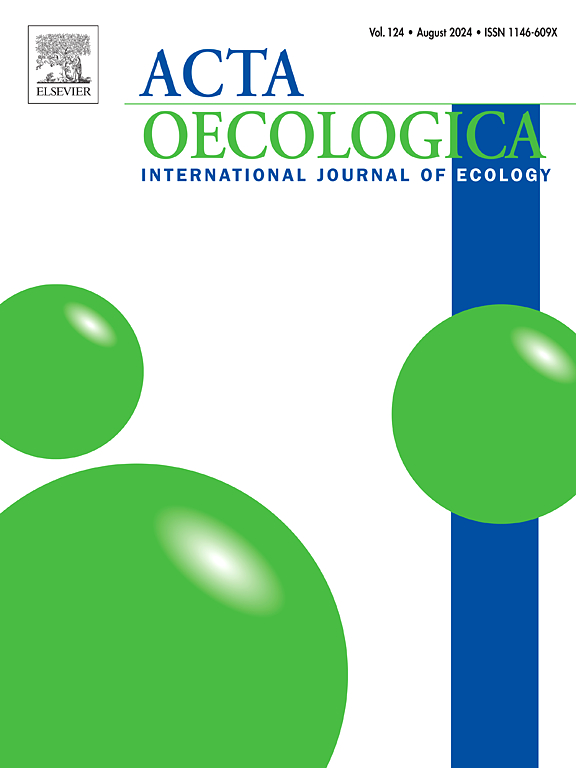模拟氮沉降对焦子雪山寒温带针叶林凋落叶分解和养分释放的影响
IF 1.3
4区 环境科学与生态学
Q3 ECOLOGY
Acta Oecologica-International Journal of Ecology
Pub Date : 2025-04-16
DOI:10.1016/j.actao.2025.104079
引用次数: 0
摘要
凋落物分解是陆地生态系统养分循环的关键过程。它是全球碳收支的重要组成部分,深受全球大气氮沉降的影响。然而,不同施氮形式对亚热带寒温带针叶林凋落物分解和养分释放的影响尚不清楚。采用NH4、2SO4、NaNO3和NH4NO3三种氮源进行梯度氮沉积。每个氮源分为4个处理,分别为CK(对照0 kg N·hm−2·a−1)、低氮(低氮5 kg N·hm−2·a−1)、中氮(中氮15 kg N·hm−2·a−1)和高氮(高30 kg N·hm−2·a−1)。结果表明:(NH4)2SO4、NaNO3和NH4NO3处理2年后凋落叶干物质平均残留率分别为41.78%、48.56%和38.78%;2年后,与对照相比,低、中NH4NO3处理凋落物分解速度最快,高、低NaNO3处理凋落物分解速度最慢。在相同N沉降条件下,低N处理凋落物分解速率高于高N处理。凋落物分解速率顺序为NH4NO3 >;(NH4) 2 so4比;NaNO3。N沉降促进了凋落叶中营养元素C的释放,但使N和P的含量略有增加。P随时间的变化比C和N的变化更为复杂,凋落叶中C、N和P的释放量大于富集的凋落叶。上述结果表明,在亚热带高原寒温带针叶林中,施氮能促进凋落叶中叶片的分解,从而释放出C、N、P等营养物质。本文章由计算机程序翻译,如有差异,请以英文原文为准。
Effects of simulated nitrogen deposition on the decomposition of leaf litter and release of nutrients in a cold temperate coniferous forest in the Jiaozi Snow Mountains National Nature Reserve in southwest China
The decomposition of litter is a key process of nutrient cycling in terrestrial ecosystems. It is an important part of the global carbon budget and deeply affected by the global atmospheric N deposition. However, the effects of different forms of N addition on litter decomposition and nutrient release are unclear in a cold temperate coniferous forest in a subtropical Chinese plateau. Three N sources (NH4)2SO4, NaNO3, and NH4NO3 were used in the gradient N deposition method. Each N source was divided into four treatments, which included the CK (control 0 kg N·hm−2·a−1), low N (low-N 5 kg N·hm−2·a−1), medium N (medium-N 15 kg N·hm−2·a−1), and high N (high-30 kg N·hm−2·a−1). The results showed that the average residual rates of dry matter in the leaves litters treated with (NH4)2SO4, NaNO3, and NH4NO3 were 41.78 %, 48.56 %, and 38.78 % after two years of decomposition, respectively. After two years, the litter decomposition rates of low and medium NH4NO3 treatments were the quickest compared with the control, while those of the high and low treatments of NaNO3 were the slowest. Under the same N deposition conditions, the litter decomposition rates of low N treatments were higher than high N treatments. The order of litter decomposition rates was NH4NO3 > (NH4)2SO4 > NaNO3. N deposition promoted the release of nutrient element C in the litter leaves but slightly increased the contents of N and P. The changes in P over time were more complex than those of C and N. Greater amounts of C, N, and P were released in litter leaves than those that were enriched. These results indicate that treatment with N can promote the decomposition of leaves in the litter leaves and thereby release C, N, and P as nutrients in a cold temperate coniferous forest on a subtropical Chinese plateau.
求助全文
通过发布文献求助,成功后即可免费获取论文全文。
去求助
来源期刊
CiteScore
3.60
自引率
0.00%
发文量
57
审稿时长
>0 weeks
期刊介绍:
Acta Oecologica is venue for the publication of original research articles in ecology. We encourage studies in all areas of ecology, including ecosystem ecology, community ecology, population ecology, conservation ecology and evolutionary ecology. There is no bias with respect to taxon, biome or geographic area. Both theoretical and empirical papers are welcome, but combinations are particularly sought. Priority is given to papers based on explicitly stated hypotheses. Acta Oecologica also accepts review papers.

 求助内容:
求助内容: 应助结果提醒方式:
应助结果提醒方式:


